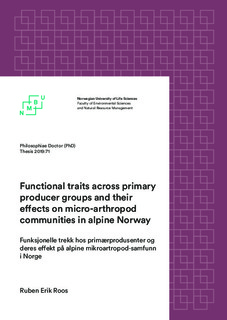| dc.contributor.advisor | Asplund, Johan | |
| dc.contributor.advisor | Birkemoe, Tone | |
| dc.contributor.advisor | Klanderud, Kari | |
| dc.contributor.author | Roos, Ruben Erik | |
| dc.coverage.spatial | Norway | nb_NO |
| dc.date.accessioned | 2019-09-26T10:47:21Z | |
| dc.date.available | 2019-09-26T10:47:21Z | |
| dc.date.issued | 2019 | |
| dc.identifier.isbn | 978-82-575-1631-4 | |
| dc.identifier.issn | 1894-6402 | |
| dc.identifier.uri | http://hdl.handle.net/11250/2618939 | |
| dc.description.abstract | The vegetation of alpine ecosystems, i.e. those above the elevation of the tree line, consists not only of vascular plants, but also of non-vascular primary producers such as lichens and bryophytes. The use of functional traits (characteristics that determine a species’ ecological role) allows us to understand how these ecosystems will respond to current and future environmental change. However, we know little about how non-vascular primary producer traits respond across environmental gradients, and whether their drivers differ from those of vascular plants. In addition, there is little knowledge about the associations of lichens and their traits with higher trophic levels such as micro-arthropods. Therefore, this thesis consists of four papers that collectively address several aspects of the ecology of non-vascular primary producers and micro-arthropods in alpine ecosystems.
In paper I, we studied the importance of intraspecific variation versus species turnover as drivers of community-level traits across elevation for three different primary producer groups: vascular plants, bryophytes, and lichens. We found that the importance of intraspecific variation differs between the groups, but also among traits. Intraspecific variation was most important as driver of nutrient traits for vascular plants and lichens.
In paper II and III, we explore the associations between mat-forming lichens and soil micro-arthropods. We found that mat-forming lichen species that differentially affect soil microclimate support different micro-arthropod abundances (paper II). For mat-forming lichens grown in mixture, we found that they often support higher abundances of micro-arthropods than expected from the individual components of the mixture. The abundance of arthropods at higher trophic levels depended more on lichen water holding capacity and prey availability than lichen diversity or identity.
In paper IV, we assessed the recovery of soil micro-arthropods from experimental environmental change nine years after treatments were ceased. We found that Collembola and Mesostigmata recovered in terms of abundance, but that Collembola community compositions remained affected.
The findings of these studies stress the importance of intraspecific variation as driver of community-level traits in different primary producers, and provide a valuable first insight in the ecology and associations of very common organisms in alpine ecosystems: non-vascular primary producers and micro-arthropods. | nb_NO |
| dc.description.abstract | Vegetasjonen i alpine økosystemer, det vil si over skoggrensen, består ikke bare av karplanter, men også av laver og moser. Bruken av funksjonelle trekk (kjennetegn som har betydning for arters opptreden) gir oss mulighet til å forstå hvordan økosystemer vil respondere på nåværende og kommende miljøendringer. Vi vet imidlertid lite om hvordan trekkene hos primærprodusenter uten ledningsvev (f.eks. laver og moser) responderer langs miljøgradienter, og hvordan dette skiller seg fra hvordan karplanter responderer. Dessuten er det liten kunnskap om hvordan laver og deres trekk samspiller med høyere trofiske nivåer som f.eks. mikroartropoder. Denne avhandlingen består av fire artikler som til sammen tar for seg flere aspekter av økologien til primærprodusenter uten ledningsvev og mikroartropoder i alpine økosystemer. | nb_NO |
| dc.language.iso | eng | nb_NO |
| dc.publisher | Norwegian University of Life Sciences, Ås | nb_NO |
| dc.relation.ispartofseries | PhD Thesis;2019:71 | |
| dc.rights | Attribution-NonCommercial-NoDerivatives 4.0 Internasjonal | * |
| dc.rights.uri | http://creativecommons.org/licenses/by-nc-nd/4.0/deed.no | * |
| dc.title | Functional traits across primary producer groups and their effects on micro-arthropod communities in alpine Norway | nb_NO |
| dc.title.alternative | Funksjonelle trekk hos primærprodusenter og deres effekt på alpine mikroartropod-samfunn i Norge | nb_NO |
| dc.type | Doctoral thesis | nb_NO |

